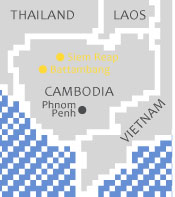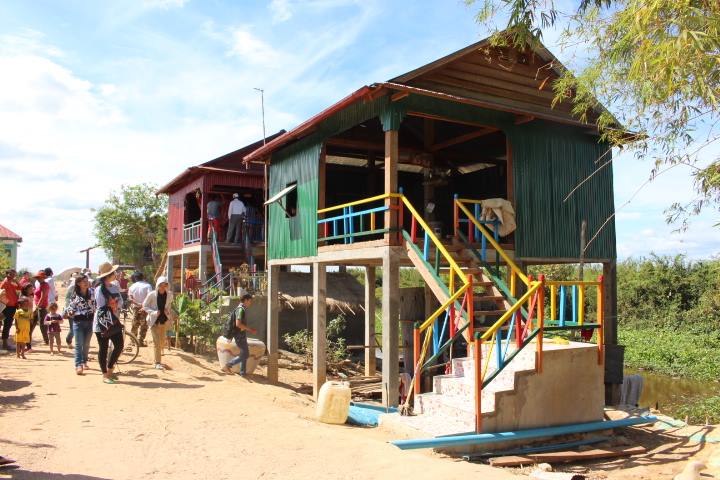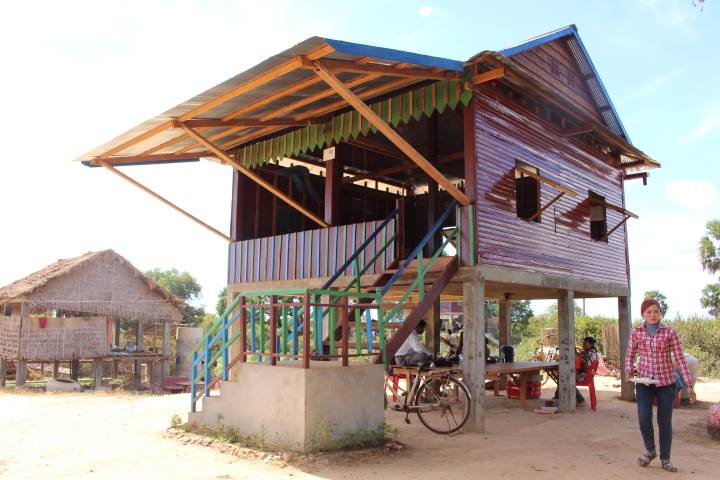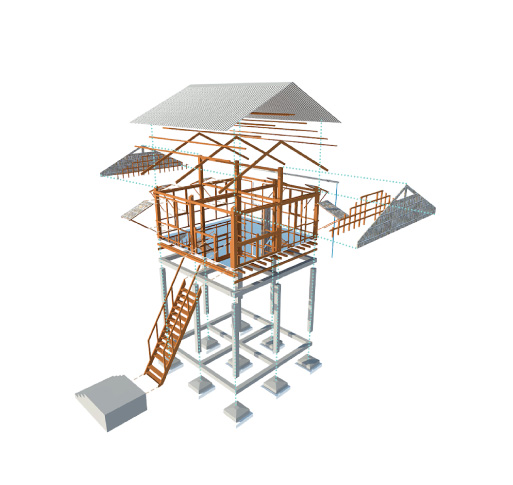 actions
actions
Cost-effective Resilient Housing: a community-based approach in Svay Chek
In October 2013 Cambodia was hit by cyclones Wutip and Nari, causing heavy flooding across the whole country. In response UN-Habitat and Malteser International made an agreement to provide shelter recovery assistance in the form of participatory design and rebuilding assistance for the communities most severely hit by the disasters. The Community Development Foundation was invited by UN-Habitat Cambodia to facilitate in participatory design for resilient shelter and implementation of low-cost cyclone-proof housing in 2 villages exposed to cyclones, Svay Chek and Ta Ngaen, in Siem Reap and Battambang provinces.
In preparation for the design process the Community Architects Network of Cambodia (CAN-Cam) conducted preliminary land-use, hazard exposure and impact mapping of the area, as well as a needs assessment in the beneficiary villages, and established a Community Construction Committee which would oversee the implementation of the project. In addition to cyclone exposure, during the monsoon season Siem Reap province is subject to heavy flooding, impacting the health and livelihoods of fisherman and farmers greatly, so the need to decrease water-related illnesses and preserve livelihoods was also an objective in addition to identifying low-cost building materials, alternative land use options and resilient housing design. CDF/CAN-Cam design team worked with volunteer participants from the communities and students from Cambodian Mekong University, Norton University and the Royal University of Fine Art.
Preliminary design ideas: in the first design workshop, we explored preliminary design ideas. We organised a role play exercise, for members of the community to make models and drawings of their own flood- and cyclone-friendly dream houses. The exercise was beneficial because it revealed important information about the existing conditions, such as flood heights, exposure and impact, local architectural styles and design solutions, landscaping, as well as technical ideas to reduce the impact of flooding and wind. We took the preliminary design ideas to technical advisers at UN-Habitat Cambodia to develop and redefine the shelter prototype.
Materials and technical detailing: the second design workshop focused on the prototype details, starting with an availability survey of local materials. We presented back to the community our defined prototype of resilient housing design for feedback, and developed the technical detailing further based on results of the survey and skills available in the community.
Technique and implementation: in the third workshop we translated the housing design back to Svay Chek village, and began construction training and participatory cost budgeting with communities and local builders. To communicate the technical detailing of the prototype shelter, The CAN-Cam team designed a poster using simple drawings to break down the design in basic elements. Previously Svay Chek village had formed a savings group, but overtime as the condition of the neighbourhood deteriorated, residents developed mistrust and started to drop out. When the cyclone hit, the savings group was finally cancelled. However, thanks to a role play exercise within the training workshop, a nearby community in the district, part of CDF’s network, was able to share convincingly the benefit of savings groups on the village, and persuade the Svay Chek community to reestablish their savings groups.
It was agreed that each community was responsible for monitoring the construction process and financial management themselves, with support by CAN-Cam. After the construction cost estimates were ready, negotiations were held between the builders and bulk material suppliers, and bank transfers of the grant instalments could begin.
In preparation for the design process the Community Architects Network of Cambodia (CAN-Cam) conducted preliminary land-use, hazard exposure and impact mapping of the area, as well as a needs assessment in the beneficiary villages, and established a Community Construction Committee which would oversee the implementation of the project. In addition to cyclone exposure, during the monsoon season Siem Reap province is subject to heavy flooding, impacting the health and livelihoods of fisherman and farmers greatly, so the need to decrease water-related illnesses and preserve livelihoods was also an objective in addition to identifying low-cost building materials, alternative land use options and resilient housing design. CDF/CAN-Cam design team worked with volunteer participants from the communities and students from Cambodian Mekong University, Norton University and the Royal University of Fine Art.
Preliminary design ideas: in the first design workshop, we explored preliminary design ideas. We organised a role play exercise, for members of the community to make models and drawings of their own flood- and cyclone-friendly dream houses. The exercise was beneficial because it revealed important information about the existing conditions, such as flood heights, exposure and impact, local architectural styles and design solutions, landscaping, as well as technical ideas to reduce the impact of flooding and wind. We took the preliminary design ideas to technical advisers at UN-Habitat Cambodia to develop and redefine the shelter prototype.
Materials and technical detailing: the second design workshop focused on the prototype details, starting with an availability survey of local materials. We presented back to the community our defined prototype of resilient housing design for feedback, and developed the technical detailing further based on results of the survey and skills available in the community.
Technique and implementation: in the third workshop we translated the housing design back to Svay Chek village, and began construction training and participatory cost budgeting with communities and local builders. To communicate the technical detailing of the prototype shelter, The CAN-Cam team designed a poster using simple drawings to break down the design in basic elements. Previously Svay Chek village had formed a savings group, but overtime as the condition of the neighbourhood deteriorated, residents developed mistrust and started to drop out. When the cyclone hit, the savings group was finally cancelled. However, thanks to a role play exercise within the training workshop, a nearby community in the district, part of CDF’s network, was able to share convincingly the benefit of savings groups on the village, and persuade the Svay Chek community to reestablish their savings groups.
It was agreed that each community was responsible for monitoring the construction process and financial management themselves, with support by CAN-Cam. After the construction cost estimates were ready, negotiations were held between the builders and bulk material suppliers, and bank transfers of the grant instalments could begin.
Location:
Cambodia

Team:
CAN-CAM
Year:
2013
Cost-effective Resilient Housing: a community-based approach in Svay Chek
Cost-effective Resilient Housing: a community-based approach in Svay Chek



